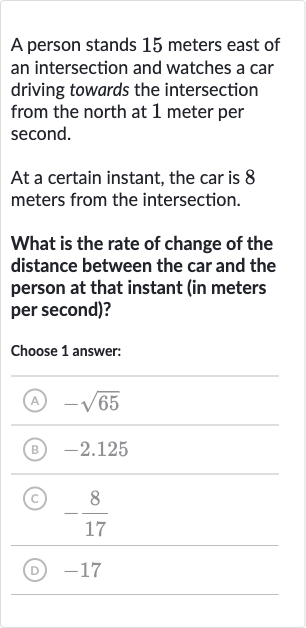AI tutor
Welcome to Bytelearn!
Let’s check out your problem:

A person stands meters east of an intersection and watches a car driving towards the intersection from the north at meter per second.At a certain instant, the car is meters from the intersection.What is the rate of change of the distance between the car and the person at that instant (in meters per second)?Choose answer:(A) (B) .(C) (D)
Full solution
Q. A person stands meters east of an intersection and watches a car driving towards the intersection from the north at meter per second.At a certain instant, the car is meters from the intersection.What is the rate of change of the distance between the car and the person at that instant (in meters per second)?Choose answer:(A) (B) .(C) (D)
- Draw Triangle: First, let's draw a right triangle where the car's distance to the intersection is one leg ( meters), and the person's distance to the intersection is the other leg ( meters). The hypotenuse will be the distance between the car and the person.
- Use Pythagorean Theorem: Now, we'll use the Pythagorean theorem to find the hypotenuse. That's , where is meters, is meters, and is the hypotenuse.
- Calculate Hypotenuse: So, gives us , which means .
- Find Initial Distance: Taking the square root of both sides, we get , which is meters. So the initial distance between the car and the person is meters.
- Apply Related Rates: Now, we need to find the rate of change of this distance. Since the car is moving towards the intersection, the distance between the car and the person is decreasing. We'll use related rates, where the rate of change of the distance is related to the rate of change of the car's distance to the intersection .
- Use Formula: Given that is meter per second (since the car is moving at meter per second towards the intersection), we can use the formula for related rates in a right triangle: , where is the car's distance to the intersection and is the hypotenuse.
- Calculate Rate of Change: Plugging in the values, we get . This simplifies to .
- Consider Negative Rate: However, since the distance is decreasing, the rate of change should be negative. So, the rate of change of the distance between the car and the person is meters per second.
More problems from Rate of travel: word problems
QuestionGet tutor help
QuestionGet tutor help
QuestionGet tutor help
QuestionGet tutor help
QuestionGet tutor help
QuestionGet tutor help
QuestionGet tutor help
QuestionGet tutor help
